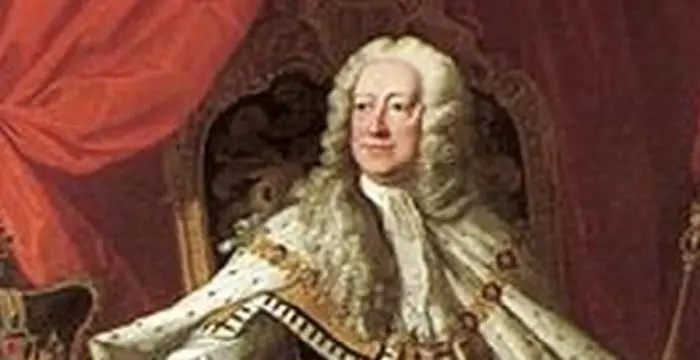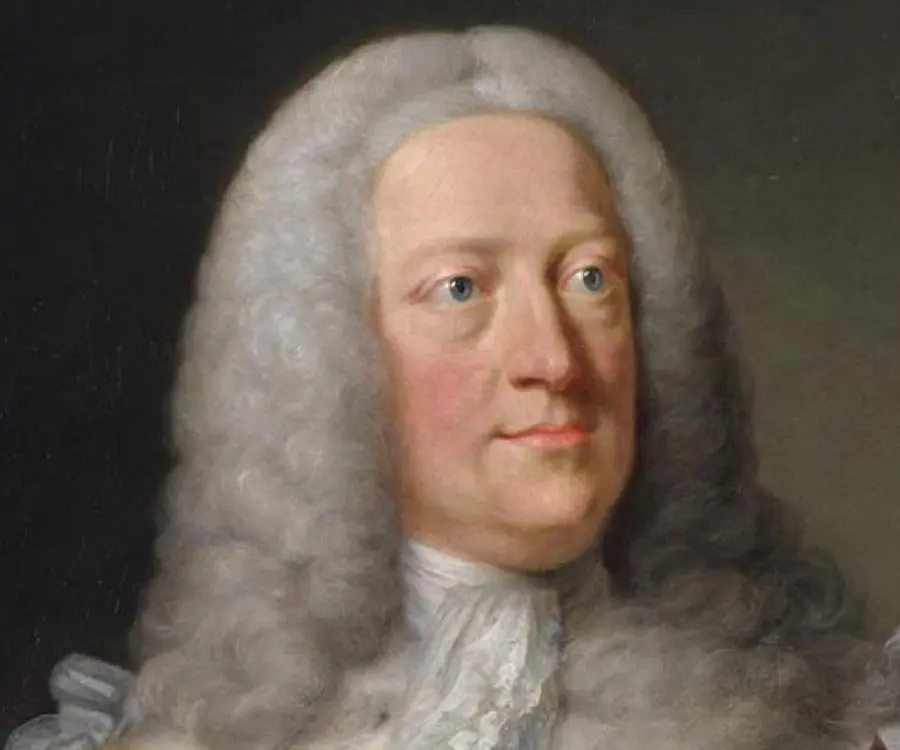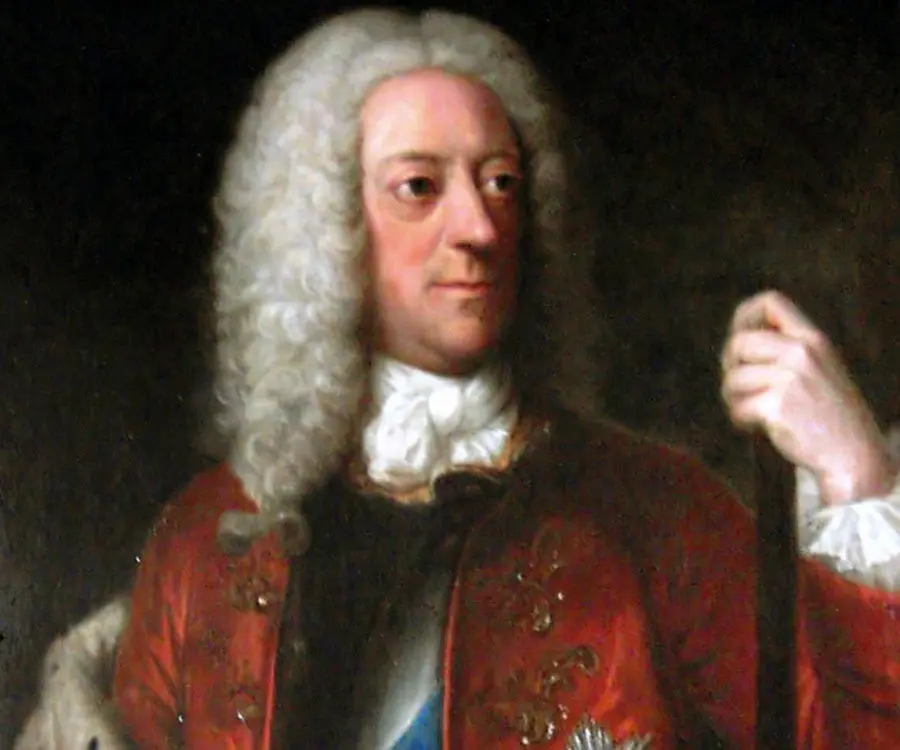
George II of Great Britain - Emperors, Family and Family
George II of Great Britain's Personal Details
George II was the King of Great Britain and Ireland from 1727 to 1760
| Information | Detail |
|---|---|
| Birthday | October 30, 1683 |
| Died on | October 25, 1760 |
| Nationality | German, British |
| Famous | Historical Personalities, Emperors & Kings, Emperors, Former King of Great Britain, Kings |
| Spouses | Queen Caroline |
| Known as | George Augustus |
| Childrens | Anne; Princess Royal and Princess of Orange, Frederick; Prince of Wales, Johann Ludwig; Reichsgraf von Wallmoden-Gimborn, Louise of Great Britain, Prince George William, Prince William; Duke of Cumberland, Princess Amelia of Great Britain, Princess Caroline of Great Britain, Princess Mary of Great Britain |
| Birth Place | Hanover |
| Born Country | Germany |
| Gender | Male |
| Father | George I of Great Britain |
| Mother | Sophia Dorothea of Celle |
| Sun Sign | Scorpio |
| Born in | Hanover |
| Famous as | Former King of Great Britain & Ireland |
| Died at Age | 76 |
George II of Great Britain's photo
Who is George II of Great Britain?
George II was the King of Great Britain and Ireland from June 1727 to October 1760. He was also the Duke of Brunswick-Lüneburg and a prince-elector of the Holy Roman Empire during the period of his reign. Born in in Hanover, northern Germany, he was the last British monarch to be born outside of Great Britain. He was the elder one of the two children of King George I of Great Britain and Sophia Dorothea of Celle. When he was eleven years old, his parents’ marriage was dissolved due to adultery. Following this, his mother was confined at the Castle of Ahlden and he never saw her again. After King George I passed away in 1727, George was crowned as the next king at Westminster Abbey. Despite being the king, he had little control over British domestic policy, as it was controlled by the Parliament of Great Britain. Years later, he led the Battle of Dettingen, which took place during the War of the Austrian Succession, becoming the last British monarch to ever lead an army to battle. He lived till the age of almost 77, longer than many of his English predecessors, and died on 25 October 1760. He was buried in Westminster Abbey, becoming the last monarch to be buried there. He was succeeded by his grandson, King George III.
// Famous Kings
Sundiata Keita
Sundiata Keita was the founder of the Mali Empire in West Africa. This biography profiles his childhood, early life, struggles, founding of empire, rule, administration, achievements and also gives some fun facts.
Ashoka
Ashoka was the third emperor of the Mauryan Dynasty and ruled almost the entire Indian subcontinent. This biography profiles his childhood, life, reign, achievements and timeline
Murad IV
Murad IV was one of the mighty Sultans in the history of the Ottoman Empire. This biography profiles his childhood, family, accession, rule, administration and timeline.
Childhood & Early Life
George was born in the city of Hanover in Germany, on 30th October 1683 as the son of George Louis, Hereditary Prince of Brunswick-Luneburg, and Sophia Dorothea of Celle. He had a sister named Sophia Dorothea, who was born when he was three years old.
The marriage of his parents was dissolved in 1694 after they both committed adultery. His mother was then confined at Ahlden House and her children never saw her again.
He was brought up in northern Germany. He initially spoke French and later was taught German as well by one of his tutors. He also learnt English and Italian, and was trained in military history and battle tactics.
He became a naturalized British citizen through the Sophia Naturalization Act in 1705 and was created a Knight of the Garter the next year, Duke and Marquess of Cambridge, Earl of Milford Haven, Viscount Northallerton, and Baron Tewkesbury in the Peerage of England.
Marriage & Children
George’s father didn’t wish for his son to have a loveless arranged marriage and wanted him to meet his bride before they made any arrangements. In 1705, in order to investigate a marriage prospect, he visited the Ansbach court anonymously at their summer residence of Triesdorf, to meet a potential bride named ‘Caroline of Ansbach’. George was very impressed by her good character and the two got married very soon.
Although George had a few mistresses, which Caroline knew about, their marriage was very happy and successful. They had a total of eight children, and through their children’s marriages, George and Caroline would eventually become the ancestors of many European royal families.
Their children were Frederick, Prince of Wales; Anne, Princess Royal; Princess Amelia; Princess Caroline; Prince George William (died in infancy); Prince William, Duke of Cumberland; Princess Mary; and Princess Louisa.
Life as a Prince
George was very eager to take part in the war against France in Flanders. However, his father didn’t allow him to join the army until he had a son and an heir. Caroline gave birth to a son in 1707. However, she fell ill with smallpox, and her illness was transmitted to George as well. Both recovered eventually.
In 1708, George took part in the Battle of Oudenarde. During the battle, he fought as a part of the Hanoverian cavalry. Though his horse and a colonel beside him were killed in the fierce battle, George survived unharmed. He played an important role in the war, according to the British commander Marlborough.
In 1714, Queen Anne—the reigning monarch of England, Scotland, and Ireland—began experiencing serious health issues and passed away. Following this, George’s father, who had a claim to the throne, became the king and being the king’s son, George was named the Prince of Wales.
When George returned to Hanover for six months, he was given some power as the ‘Guardian and Lieutenant of the Realm’, in order to govern in the absence of his father. As George’s popularity grew, a sense of distrust and jealousy developed between him and his father. This led to a poor relationship between them. Several other issues also contributed to their increasingly troubled relations.
Displeased with his son, the king banished George and Caroline from the court. The couple then went to Leicester Square where they remained for a few years. Their children were kept in the custody of their grandfather.
Ascension & Reign
King George I eventually passed away on 11th June 1727 in Hanover. George succeeded him as George II of Great Britain and was crowned at Westminster Abbey on 22 October 1727.
George II decided not to visit Germany for his father’s funeral. This decision didn’t bring him criticism, but instead brought him praise as it showed his fondness for England. He also suppressed his father’s will as it attempted to split the Hanoverian succession between George II’s future grandsons.
Like his father, he also had a poor relationship with his eldest son, Frederick, Prince of Wales. King George II and his wife Caroline went to live in Great Britain, leaving behind a seven-year-old Frederick in the care of his great-uncle Ernest Augustus.
When Frederick, who was given the title of Duke of Cornwall, was summoned to London after many years, he was not even greeted by officials despite being the heir to the throne.
War broke out with Spain in 1739. Three years later, Robert Walpole, who had been charge of the government since 1721, resigned. George II found another mentor named John Carteret, and they together brought England into the War of the Austrian Succession. George II led his troops into battle against the French at Dettingen, which made him the last British monarch to lead his army into battle.
Meanwhile, Queen Caroline also played an important role in government affairs, with a level of involvement higher than that of any other queen consort since the Middle Ages. She passed away in 1737, after which George II promised never to marry again, though she wanted him to.
His son Frederick passed away in 1751, at the age of 44. King George II was playing cards with his mistress, when he was told of Frederick’s death. However, he continued playing, saying that he was glad. This showed the degree of contempt he had for his son.
It is believed by many historians that during George II’s reign, the important decisions were mostly made by Walpole and other senior ministers; the role that the king played was honorific.
The British National Anthem is known to have originated during the reign of George II. The earliest version ‘God Save Great George Our King’ was first heard when George II attended a gala performance in 1745.
George II eventually started losing interest in politics towards the end of his reign. While Britain was involved in the Seven Years’ War from 1756 to 1763, it was primarily overseen by William Pitt the Elder and not the king. During this period, British influence also grew in their colonies, such as India and Canada.
Major Battles
King George II commanded his troops in the Battle of Dettingen during the War of the Austrian Succession. The British forces allied with the forces of Hanover and Hesse to defeat a French army under the duc de Noailles. This battle marked the last time a British monarch personally led his troops on the field.
Death & Legacy
By late 1760, George II had become hard of hearing as well as blind in one eye. He eventually passed away on 25 October the same year. He was nearly 77 at the time of his death and had lived longer than any of his British predecessors. The cause of his death was found to be an aortic aneurysm.
He was buried at Westminster Abbey, becoming the last monarch to be buried there. He had left instructions for the sides of his and wife’s coffins to be removed, in order for their remains to be together.
He was succeeded by his grandson George William Frederick, known as King George III, who ruled from 1760 to 1820.
// Famous Emperors
Sundiata Keita
Sundiata Keita was the founder of the Mali Empire in West Africa. This biography profiles his childhood, early life, struggles, founding of empire, rule, administration, achievements and also gives some fun facts.
Ashoka
Ashoka was the third emperor of the Mauryan Dynasty and ruled almost the entire Indian subcontinent. This biography profiles his childhood, life, reign, achievements and timeline
Murad IV
Murad IV was one of the mighty Sultans in the history of the Ottoman Empire. This biography profiles his childhood, family, accession, rule, administration and timeline.
George II of Great Britain biography timelines
- // 30th Oct 1683George was born in the city of Hanover in Germany, on 30th October 1683 as the son of George Louis, Hereditary Prince of Brunswick-Luneburg, and Sophia Dorothea of Celle. He had a sister named Sophia Dorothea, who was born when he was three years old.
- // 1694The marriage of his parents was dissolved in 1694 after they both committed adultery. His mother was then confined at Ahlden House and her children never saw her again.
- // 1705He became a naturalized British citizen through the Sophia Naturalization Act in 1705 and was created a Knight of the Garter the next year, Duke and Marquess of Cambridge, Earl of Milford Haven, Viscount Northallerton, and Baron Tewkesbury in the Peerage of England.
- // 1705George’s father didn’t wish for his son to have a loveless arranged marriage and wanted him to meet his bride before they made any arrangements. In 1705, in order to investigate a marriage prospect, he visited the Ansbach court anonymously at their summer residence of Triesdorf, to meet a potential bride named ‘Caroline of Ansbach’. George was very impressed by her good character and the two got married very soon.
- // 1707George was very eager to take part in the war against France in Flanders. However, his father didn’t allow him to join the army until he had a son and an heir. Caroline gave birth to a son in 1707. However, she fell ill with smallpox, and her illness was transmitted to George as well. Both recovered eventually.
- // 1708In 1708, George took part in the Battle of Oudenarde. During the battle, he fought as a part of the Hanoverian cavalry. Though his horse and a colonel beside him were killed in the fierce battle, George survived unharmed. He played an important role in the war, according to the British commander Marlborough.
- // 1714In 1714, Queen Anne—the reigning monarch of England, Scotland, and Ireland—began experiencing serious health issues and passed away. Following this, George’s father, who had a claim to the throne, became the king and being the king’s son, George was named the Prince of Wales.
- // 1727King George I eventually passed away on 11th June 1727 in Hanover. George succeeded him as George II of Great Britain and was crowned at Westminster Abbey on 22 October 1727.
- // 1737Meanwhile, Queen Caroline also played an important role in government affairs, with a level of involvement higher than that of any other queen consort since the Middle Ages. She passed away in 1737, after which George II promised never to marry again, though she wanted him to.
- // 1739War broke out with Spain in 1739. Three years later, Robert Walpole, who had been charge of the government since 1721, resigned. George II found another mentor named John Carteret, and they together brought England into the War of the Austrian Succession. George II led his troops into battle against the French at Dettingen, which made him the last British monarch to lead his army into battle.
- // 1745The British National Anthem is known to have originated during the reign of George II. The earliest version ‘God Save Great George Our King’ was first heard when George II attended a gala performance in 1745.
- // 1751His son Frederick passed away in 1751, at the age of 44. King George II was playing cards with his mistress, when he was told of Frederick’s death. However, he continued playing, saying that he was glad. This showed the degree of contempt he had for his son.
- // 1760By late 1760, George II had become hard of hearing as well as blind in one eye. He eventually passed away on 25 October the same year. He was nearly 77 at the time of his death and had lived longer than any of his British predecessors. The cause of his death was found to be an aortic aneurysm.
// Famous Emperors & Kings
Sundiata Keita
Sundiata Keita was the founder of the Mali Empire in West Africa. This biography profiles his childhood, early life, struggles, founding of empire, rule, administration, achievements and also gives some fun facts.
Ashoka
Ashoka was the third emperor of the Mauryan Dynasty and ruled almost the entire Indian subcontinent. This biography profiles his childhood, life, reign, achievements and timeline
Murad IV
Murad IV was one of the mighty Sultans in the history of the Ottoman Empire. This biography profiles his childhood, family, accession, rule, administration and timeline.
Xerxes I
Xerxes I (Xerxes the Great) was the fourth and the most famous king of the Archaemenid dynasty of Persia. This biography profiles his childhood, family, personal life, life history, achievements, campaigns, administration, death and other facts.
Sargon of Akkad
Sargon of Akkad, also called ‘Sargon the Great’, ‘Sarru-Kan’ and ‘Shar-Gani-Sharri’, was the founder and first king of the Akkadian Empire. This biography profiles his childhood, life, rule, administration, timeline, and gives some fun facts.
Abdullah of Saudi Arabia
Abdullah bin Abdulaziz Al Saud was the King of Saudi Arabia from 2005 to 2015 and the third wealthiest head of state in the world. Find more facts about his life, childhood and timeline.
George II of Great Britain's FAQ
What is George II of Great Britain birthday?
George II of Great Britain was born at 1683-10-30
When was George II of Great Britain died?
George II of Great Britain was died at 1760-10-25
Which age was George II of Great Britain died?
George II of Great Britain was died at age 76
Where is George II of Great Britain's birth place?
George II of Great Britain was born in Hanover
What is George II of Great Britain nationalities?
George II of Great Britain's nationalities is German, British
Who is George II of Great Britain spouses?
George II of Great Britain's spouses is Queen Caroline
Who is George II of Great Britain childrens?
George II of Great Britain's childrens is Anne; Princess Royal and Princess of Orange, Frederick; Prince of Wales, Johann Ludwig; Reichsgraf von Wallmoden-Gimborn, Louise of Great Britain, Prince George William, Prince William; Duke of Cumberland, Princess Amelia of Great Britain, Princess Caroline of Great Britain, Princess Mary of Great Britain
Who is George II of Great Britain's father?
George II of Great Britain's father is George I of Great Britain
Who is George II of Great Britain's mother?
George II of Great Britain's mother is Sophia Dorothea of Celle
What is George II of Great Britain's sun sign?
George II of Great Britain is Scorpio
How famous is George II of Great Britain?
George II of Great Britain is famouse as Former King of Great Britain & Ireland









